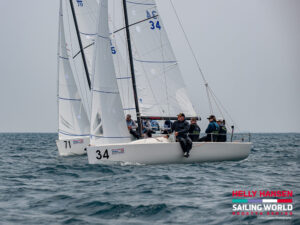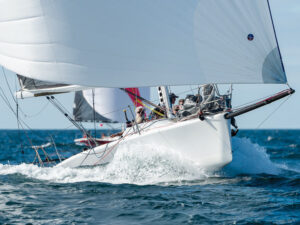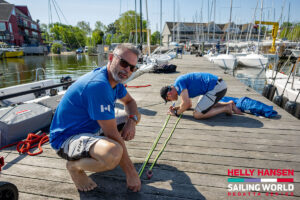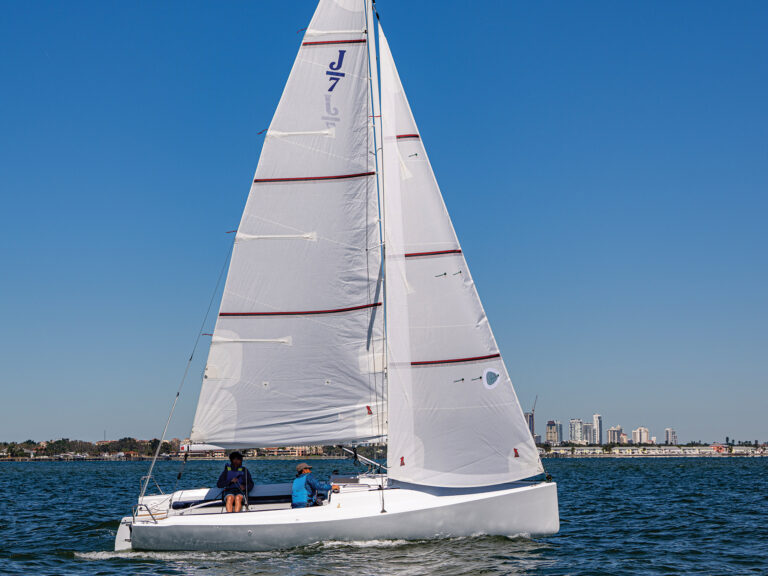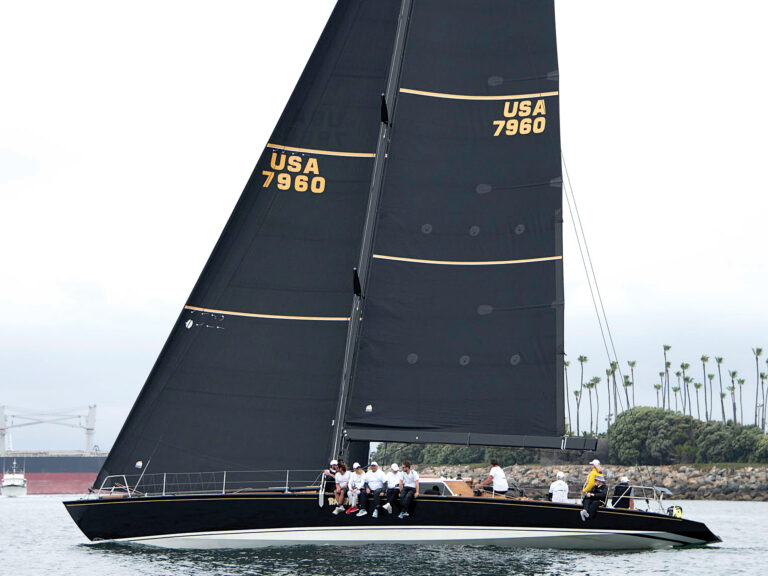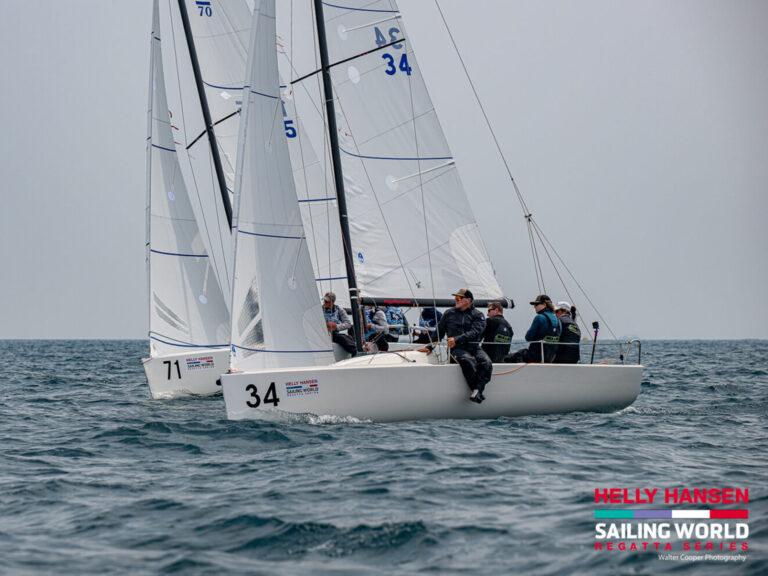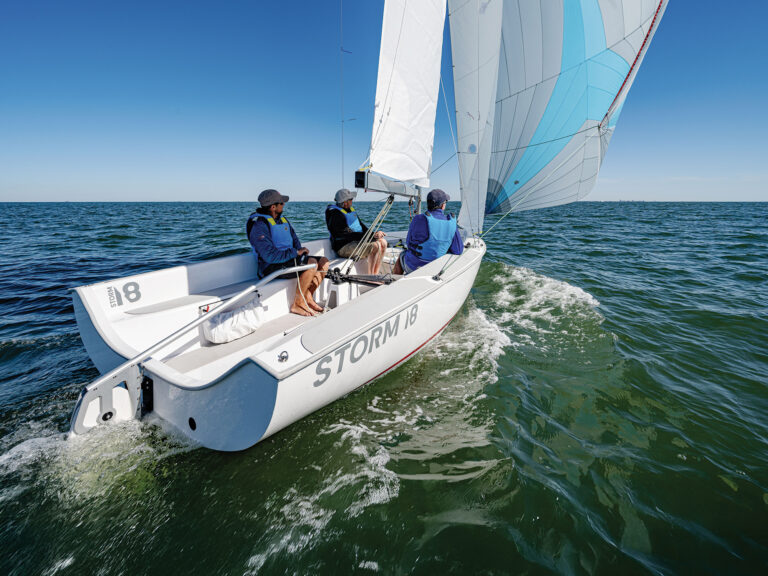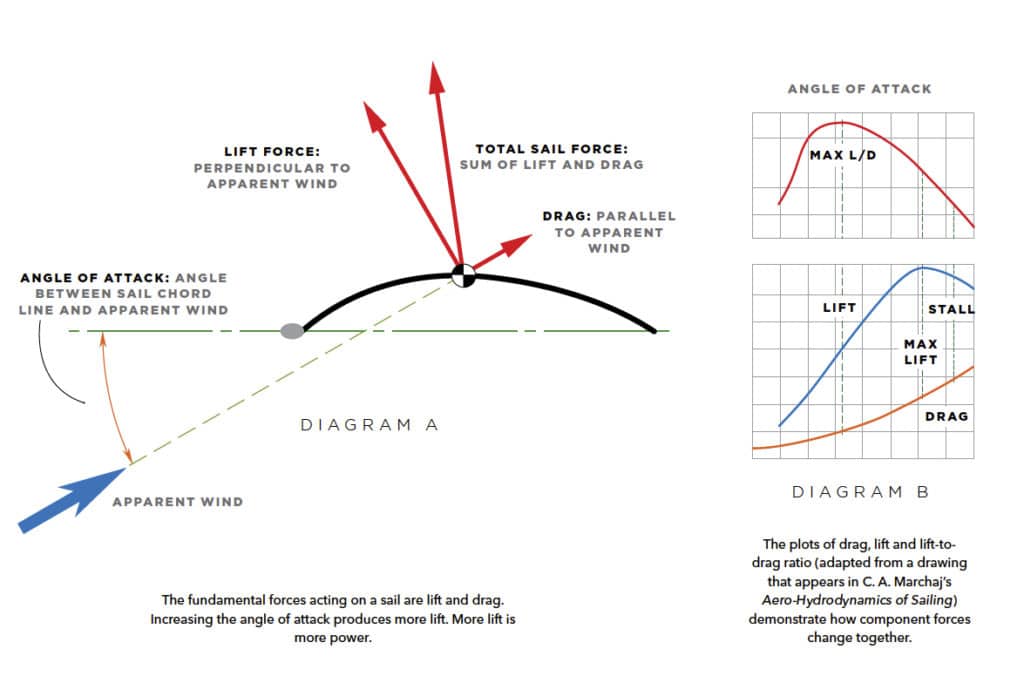
There are many ways to describe the forces around sails — in fact, around any foil. One of the most straightforward ways is to split the forces into lift and drag. The lift force is, by definition, perpendicular to the apparent-wind direction; drag is parallel to it. The primary way to get more lift from a sail is to increase its angle of attack. More lift is more power.
Two ways to increase a sail’s angle of attack: trim it, or turn the bow off the wind (fall off) without easing the sails. The most important thing to know about angle of attack is the greater it is — or to put this another way, the more the sail deflects the airflow — the greater will be the lift, up to a point. Heel force and flow separation are two of the nasty results of too high an angle of attack. A secondary way to get more lift from a sail is to increase its camber, or depth.
[As discussed in a previous chapter] the leading edge of the flat plate requires the wind to make an abrupt turn around it. Aft of the separation bubble, this abrupt turn causes the wind to change direction severely, which raises the likelihood that the boundary layer will separate from the foil. Correct camber provides a gentler turn. This, incidentally, is a benefit of the curved airplane wing: to provide a gentler introduction of the wing to the flow, which helps to keep the flow attached to the foil. This is also an advantage of a wing on a sailboat, as we first saw on the Australian C-class catamaran Miss Nylex in 1971, if not before. Contrary to the old lore, it is not curved to provide a “longer distance” for air molecules on the upper surface to travel.
Sail trim is, however, a balancing act. Too much camber also can present problems, as the flow has difficulty staying attached to a deeply curved section. With too much camber, the likelihood is that it will separate — the nice, even curve above becomes an abrupt hairpin — and the flow will depart prematurely from the sail. Too much camber can decrease lift, while increasing drag even faster. This is why steeply pitched roofs are less likely to blow off in high winds. With a steep roof (effectively deep camber), the wind’s boundary layer has difficulty making the sharp turn at the peak of the roof and separates. So attached flow is only working on half the roof, at most. With a low-pitched roof, the flow may be attached to the entire roof.
For sailors, the practical reality of this discussion is that creating lift is a cinch. All it requires is oversheeting the sails or sailing a course too low for the sail settings (both of which increase angle of attack), or sailing with sails that are too full (show too much camber) for the conditions. Unfortunately, sail trim is not so easy because its undesirable cohort — drag — offsets lift. Reducing drag, primarily because it is so difficult to see, is the tough part.
The plot of the lift-to-drag ratio, the top curve in Diagram B, shows how both of these component forces are changing together. Note that the best ratio of lift to drag (which means that the highest proportion of the force of the sail[s] is going to drive the boat) is at a point only halfway up the lift curve. At the point at which the lift is at its maximum (middle curve), the lift-to-drag ratio is well on its way downhill. Keep in mind that sails tend not to stall as abruptly as high-performance airplane wings do, so a distinct stall point is difficult to detect.
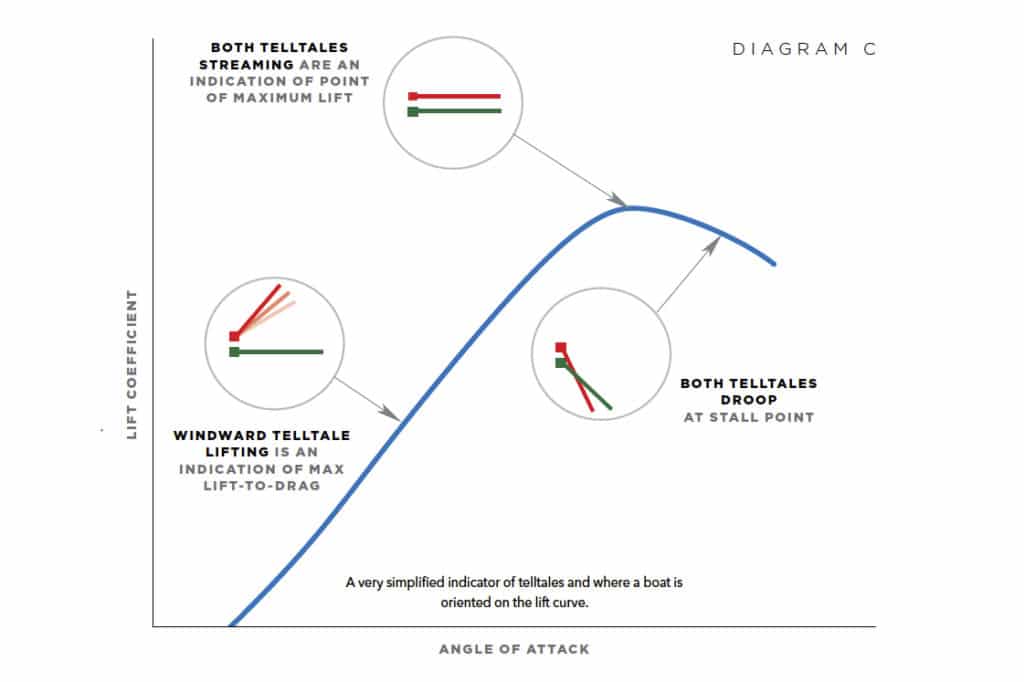
The genoa’s luff telltales are rough indicators of where you are in terms of lift and drag, at least from the perspective of angle of attack. As we now know, this is most important in terms of sail trim. When the windward telltale is just lifting, the lift-to-drag ratio reaches its highest point. As the angle of attack of the sails increases, both the windward and the leeward telltales start streaming. Here lift is near its maximum, but now it’s at the expense of drag.
The result is that the lift-to-drag ratio is lower. Keep increasing the angle of attack (trim the sails more or fall off the wind without easing them), and the boundary layer separates, and the total flow can stall. This can be seen in Diagram C with both telltales drooping.
From the preceding, it might seem that the first angle of attack — with the windward telltale lifting — is optimum for sailing to weather. This is correct, except for one additional point. That particular angle of attack does not always generate the fastest velocity made good. Some sailboats in some conditions have a higher VMG by sheeting sails relatively hard and “pressing on them,” meaning footing slightly. Other boats in other conditions improve VMG by creating deeper sectioned sails and sailing them “high,” pinching. More lift is often needed — despite the problem of even more drag — to accelerate the boat to its hull speed or to power through chop.
For example, in smooth water and medium air, if the main is trimmed such that its lift-to-drag ratio decreases, that loss could be more than offset by a higher angle of attack from the rudder, or from the fact that more of the total force created is turned into drive force. It’s why modern racing sailboats are characterized by having two upwind speed modes — underpowered (typically defined as not requiring all crew to be hiking) and powered up (all crew hiking). In the former, more drag is happily traded off for more lift, all because heel force is not yet an issue. Once powered up, heel force, therefore, becomes a big driver of sail trim.
As mentioned, creating lift is the easy part; the difficult part is minimizing drag and preventing the separation of the airflow. Obviously, drag reduces the driving force. It increases the amount of side force (heel) for a given amount of lift, and this increased heeling component can overwhelm those factors that work to counterbalance it: the keel, rudder, underbody and ballast.
Bear in mind that this discussion focuses on sailing upwind. When sailing very low downwind (high apparent-wind) angles, the name of the game is to increase drag or to stop the flow of wind. Reaching is a combination of the two, and the fact that drag becomes a benefit rather than a liability, as it is when beating, is one of the reasons why a 90-degree reach is the fastest point of sail. Another reason is that on a beam reach, the sail forces point much closer to the direction the boat travels, increasing the drive force and reducing the heel force.
The Art and Science of Sails Revised Edition (2016), by Tom Whidden and Michael Levitt ($39.95), published by Seapoint Books (seapointbooks.com), is available at Amazon, select bookstores and North Sails. It’s a perfect addition to any sailor’s library of knowledge. If you’re feeling slow, you’ll know where to go.

